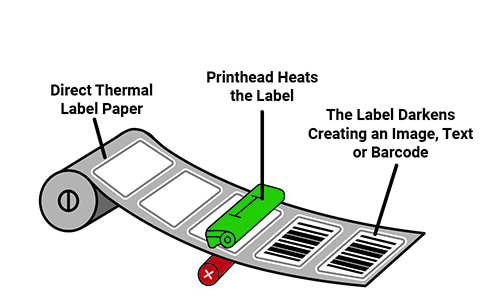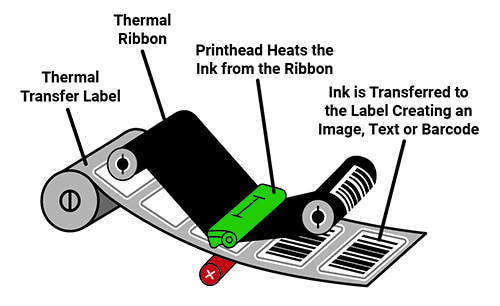Direct Thermal vs. Thermal Transfer
Posted by Advanced Automation on Dec 20th 2024

A Quick Guide Explaining the Difference Between Direct Thermal vs. Thermal Transfer Labels.
Thermal Barcode Printers are a great choice for any type of business or organization business needing on demand variable data barcode labels. More durable than other types of label printers, they operate reliably in both industrial and office settings. When it comes to thermal printing, there are two modes of thermal printing to choose from —direct thermal and thermal transfer. Each offers unique advantages. Let’s look at how they compare, so you can choose the option that best meets your specific barcode labeling application needs.
Direct Thermal Printing - Simplicity and Economy
Direct thermal printing is simple and economical because it prints without a ribbon, toner, or ink. Instead, it uses chemically treated, heat-sensitive media that blackens when it passes under the thermal printhead.
This thermal printing option is optimal for barcode printing applications requiring a short shelf life—such as shipping labels, patient and visitor identification, receipts, and ticket printing. Depending on use, the readability of direct thermal labels, wristbands, and receipt papers varies greatly. This option is not recommended for lifetime identification applications, because a direct thermal-printed label overexposed to heat or light will darken and make the text or barcode unreadable.
Thermal Transfer Printing - Enduring Readability and Scanability
Labels that are thermal transfer printed have a crisp, often glossy, surface. When heated by the printhead, a thin ribbon roll melts onto the label to form the image—absorbing the image into the media. This option offers unmatched readability and scanability with excellent edge definition—ideal for product labels and successful barcode printing and scanning.
When matched with the right media, thermal transfer technology is impervious to heat and moisture, and the image cannot be rubbed off. As a result, thermal transfer printed labels are the most durable available—withstanding temperature extremes, ultraviolet exposure, chemicals, sterilization, and more. This thermal print option is often well suited for product identification, circuit board tracking, permanent identification, sample and file tracking, asset tagging, inventory identification, cold storage and freezers, certification labels such as UL/CSA, laboratory specimens, and outdoor use.
Make the Right Thermal Printing Choice for Your Business
Want greater simplicity, lower costs, and short-term or indoor use? Direct thermal printing is likely to serve you best. Want higher-quality resolution and greater durability in any climate? Thermal transfer printing could be the way to go. This quick comparison chart can help you review the advantages of each option. Let's break it down for you!

Direct Thermal Labels
- Does not require a ribbon, for optimal simplicity but lesser durability.
- Chemically treated, heat-sensitive media passes under thermal printhead to image.
Simpler
- Easier to load
- No ribbon wrinkle or ribbon drive adjustments
- No need to pair ribbon to labels
Less Expensive
- No ribbon costs
- No need to manage SKUs
Ideal for Indoor & Short-Term Printing
- Use for applications requiring a short shelf life: shipping labels, receipts and name tags
Environmental Economy
- Recyclable materials available

Thermal Transfer Labels
- Requires a ribbon to produce longer-lasting images on a wide variety of materials.
- Printhead applies heat to the ribbon to transfer images.
More Complex
- To obtain optimum print quality, ribbon and media substrate must be compatible
Exceptional Quality
- Suitable for professional print with excellent resolution, sharpness, and clarity
- Ribbons increase costs; however, thermal transfer printheads last longer than direct thermal printheads
Ideal for Outdoor & Permanent Printing
- Wide selection of materials for the most rugged environments
- Can be exposed to extreme temperatures, liquids, and chemicals
- Use for durable applications: product identification, inventory labels and asset labeling
Less Eco-Friendly
- Thermal transfer ribbon is not recyclable
Start Making the Right Label Choices Today
Advanced Automation makes it easy for you to discover thermal label printing solutions to meet your barcode label printing objectives. We’ll help you choose the right barcode printer and thermal label combination that optimizes value and results for your business!

